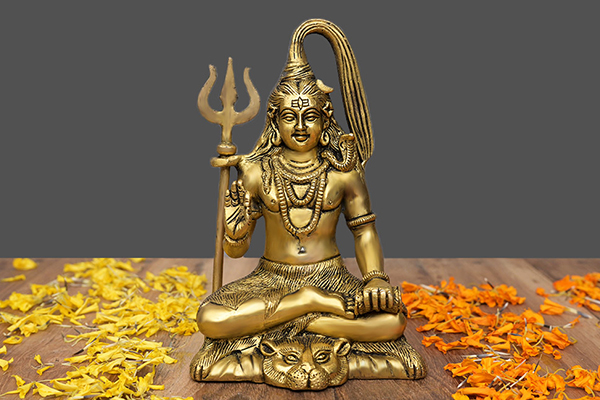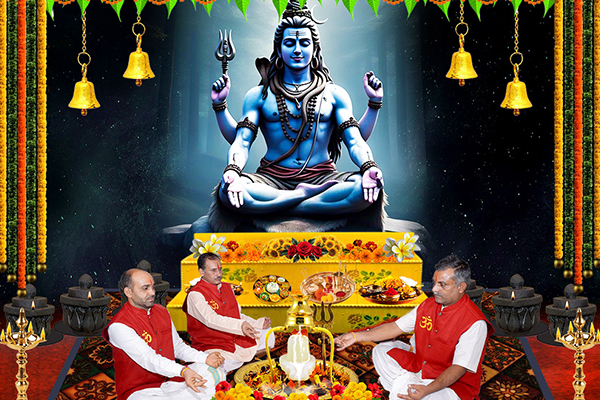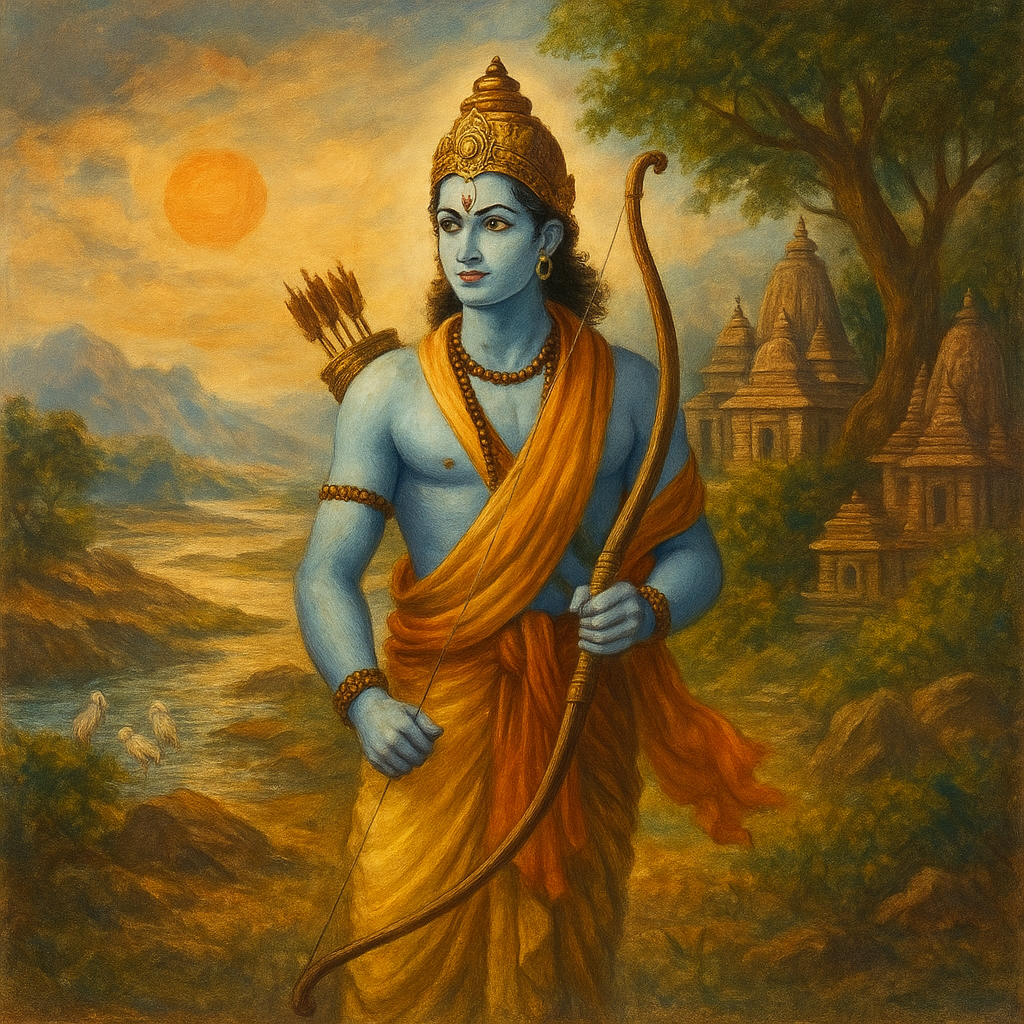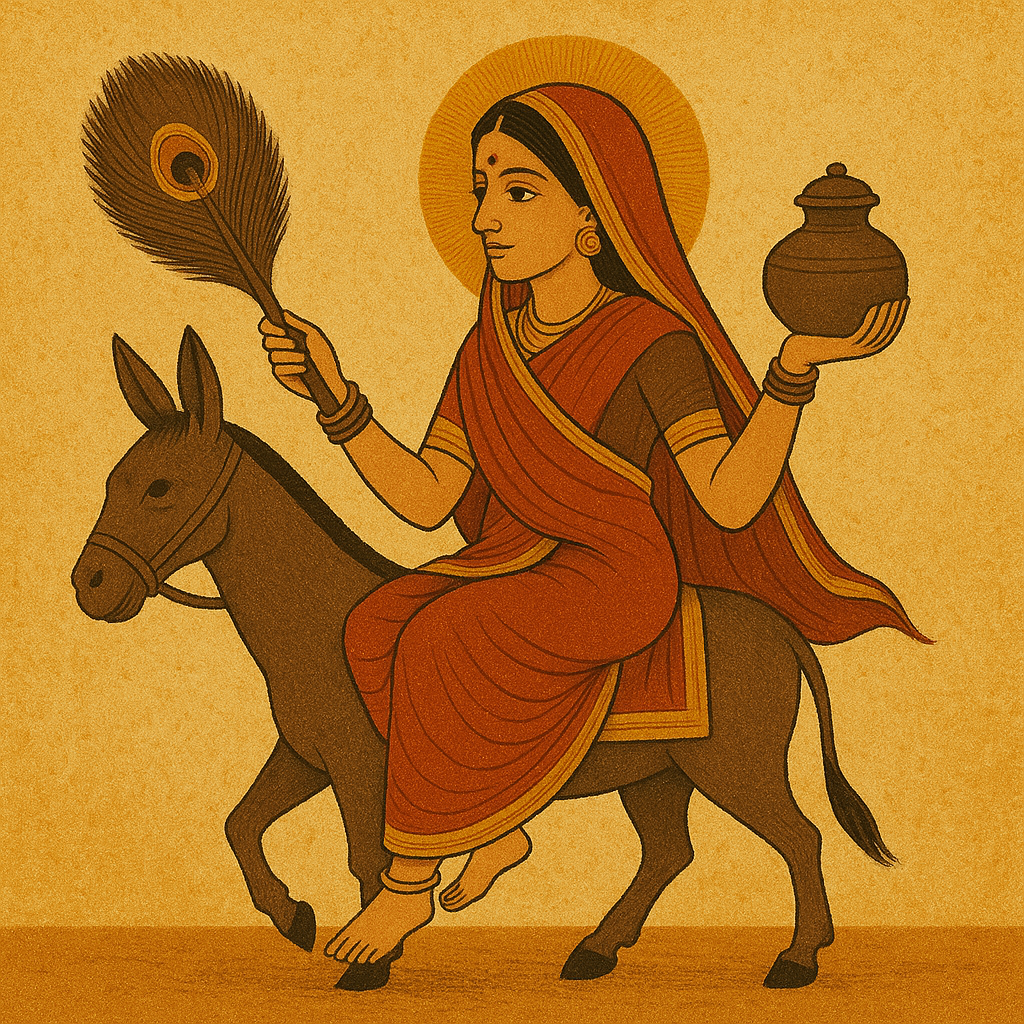
Mahesh Navami, a sacred day of profound spiritual significance, honors the worship of Bhagwan Shiva, the supreme ascetic and compassionate protector of devotees. This auspicious occasion is dedicated to the glory of Bhagwan Mahesh (Shiva) and is especially revered by the Maheshwari community, who trace their origins to His divine blessings. Mahesh Navami symbolizes the power of devotion (Bhakti), the destruction of ignorance, and the transcendence of worldly attachments through surrender to the Supreme Bhagwan.
In 2026, Mahesh Navami will be observed on
Tuesday, June 23
.
This sacred day is a time for prayers, Vedic rituals, and deep contemplation on the divine grace of Bhagwan Shiva. Devotees honor Him by offering Abhishek (ritual bathing) with milk, honey, and water, reciting Shiva mantras, and studying scriptures such as the Shiva Purana. Engaging in kirtan (devotional singing) and fasting on this day is believed to remove past sins, grant spiritual wisdom, and strengthen one's connection with the Divine.
Observing Mahesh Navami with sincerity invokes the boundless blessings of Bhagwan Shiva, leading devotees towards inner peace, strength, and ultimate liberation (Moksha).
Festival Date, Time, Muhurat & Tithi
Mahesh Navami will be observed on
Tuesday, June 23, 2026
Navami Tithi during Shukla Paksha in the month of Jyeshth as per the lunar calendar.
Key Timings for Mahesh Navami 2026:
Navami Tithi Begins - 03:39 PM on Jun 22, 2026
Navami Tithi Ends - 04:39 PM on Jun 23, 2026
The auspicious time for performing Mahesh Navami Puja is during the morning hours after
sunrise
on
Tuesday, June 23, 2026
. Devotees typically perform the puja during the Pratahkal Muhurat (early morning period), which is considered highly favorable for worshipping Bhagwan Shiva and Goddess Parvati on this day.
Note: Sunrise and sunset vary by region and date due to India's geographical diversity. For exact timings, please refer to local astronomical data.
Significance & Importance of Mahesh Navami
Mahesh Navami holds immense significance as a sacred occasion dedicated to the worship of Bhagwan Mahesh (Shiva) and the divine energy of Maa Parvati. It is a day that exemplifies devotion, faith, and the eternal bond between the divine masculine and feminine forces that govern the universe. This auspicious festival is particularly revered by the Maheshwari community, who trace their spiritual and cultural heritage back to the divine blessings of Bhagwan Shiva. The festival serves as a powerful reminder of the importance of surrender, righteousness (Dharma), and unwavering faith in the supreme protector, Mahadev.
According to ancient legend, the origins of the Maheshwari community are intricately linked to this sacred day. It is believed that during the Yudhishtir Samvat, a divine intervention by Bhagwan Shiva led to the formation of the Maheshwari dynasty. Since then, Jyeshtha Shukla Navami has been observed annually as Mahesh Navami, marking not only a religious celebration but also a day of historical and cultural pride for the Maheshwari lineage. The festival is a means of honoring their spiritual ancestry and reaffirming their commitment to the ideals of service (Seva), sacrifice (Tyaga), and righteousness (Dharma).
Beyond the historical significance, Mahesh Navami is a day of deep spiritual introspection and community bonding. Devotees engage in pujas, abhishekam, and kirtans, filling the air with the divine vibrations of Shiva mantras and bhajans. The sacred union of Shiva and Parvati is meditated upon, reminding devotees of the balance between asceticism and household life, renunciation and responsibility. The festival also fosters a sense of unity, reinforcing the belief that spiritual growth is not an individual pursuit but a collective journey.
Mahesh Navami stands as a beacon of unwavering faith and devotion, emphasizing the virtues of humility, service, and moral strength. By observing this holy day with sincerity, devotees seek the blessings of Bhagwan Shiva to remove obstacles, purify their minds, and walk the path of truth. The festival is not just about rituals but about cultivating an inner connection with the divine, reminding one that the ultimate purpose of life is to transcend worldly attachments and attain spiritual enlightenment.
According to legend, Bhagwan Mahesh guided Kshatriya Rajputs to renounce hunting and embrace a non-violent path of commerce, emphasizing righteousness and the welfare of society. The festival symbolizes the transcendence of ego and violence, promoting peace and universal well-being. It is also believed that women seeking motherhood can receive Shiva’s blessings by offering sincere prayers on this day. Worshiping Bhagwan Mahesh on Mahesh Navami is said to remove obstacles, bring happiness, and bestow divine grace upon devotees.
History & Stories of Mahesh Navami Festival
According to ancient religious scriptures, the ancestors of the Maheshwari community were once valiant Kshatriyas, bound by their warrior lineage. However, their destiny took a fateful turn during a hunting expedition when they unknowingly incurred the wrath of revered sages. Enraged by the disturbance caused to their sacred rituals, the sages cast a powerful curse, condemning the warriors to an ill fate. It was on this very day that Bhagwan Mahesh (Shiva) intervened, liberating them from the curse and guiding them toward a new path—one of nonviolence and righteousness. Thus, at the divine command of Bhagwan Shiva, these Kshatriyas renounced their weapons and embraced a life of trade and commerce, forming what is now known as the Maheshwari community.
The legend further unfolds in the prosperous kingdom of Khandela, ruled by the noble and devout Suryavanshi king, Khadgal Sen. Though his reign was marked by peace and prosperity, the king longed for a child. Determined to fulfill this wish, he performed the Putresti Yagya, a sacred fire ritual for progeny. Pleased with his devotion, the sages blessed him with a son but also forewarned him—his child would be immensely powerful and destined to be a great emperor, but he must never travel north before the age of sixteen, lest it bring untimely death to the king. Overjoyed, the king welcomed his son, naming him Sujansen, a prince of great intelligence and valor. As time passed, Sujansen was wed to the noble princess Chandravati, further strengthening the dynasty’s prosperity.

However, fate intervened when, one day, young Rajkuvar Sujansen, accompanied by 72 Umraos (a Rajput sub-caste), ventured into the northern forests on a hunting expedition. Unaware of the prophecy, they stumbled upon a sacred fire ritual performed by six great sages near Surya Kund. The air reverberated with the divine recitation of Vedic hymns, yet Sujansen, overcome by arrogance, saw the ceremony as an obstacle to his pursuit. In his fury, he commanded his men to destroy the sacred Yagya. Angered beyond measure, the sages unleashed a devastating curse, transforming Sujansen and his 72 warriors into lifeless stone. When the tragic news reached King Khadgal Sen, his heart could not bear the grief, and he succumbed to sorrow, passing away in despair.

In the wake of this calamity, Queen Chandravati, along with the wives of the 72 Umraos, approached the sages with tearful pleas, begging them to lift the terrible curse. The sages, moved by their unwavering devotion, instructed Chandravati to perform intense penance in a hidden cave, meditating upon Bhagwan Mahesh with the powerful Ashtakshar mantra—'Om Namo Maheshwarai.' With resolute faith, Chandravati, accompanied by the grieving wives, immersed herself in deep meditation, surrendering completely to the divine.
Pleased by her unwavering dedication, Bhagwan Mahesh and Maa Parvati manifested before her, radiating celestial brilliance. Chandravati, with folded hands and tearful eyes, fell at their feet, pleading for the restoration of their husbands. Touched by her devotion and selflessness, Maa Parvati bestowed her with divine blessings of Saubhagya (unbroken marital bliss). Moved by her plight, Goddess Maheshwari interceded on her behalf, urging Bhagwan Mahesh to revoke the curse. By His supreme grace, Sujansen and the 72 Umraos were returned to life, freed from their stone-bound existence.
This divine intervention became a turning point, marking the birth of the Maheshwari community, forever blessed by the benevolence of Bhagwan Shiva. The significance of Mahesh Navami lies in remembering this divine event—honoring the path of nonviolence, righteousness, and unwavering faith in Bhagwan Mahesh and Maa Parvati. Even today, devotees seek Shiva’s blessings on this sacred day, believing that His grace has the power to restore what is lost, bring peace, and guide one toward a higher purpose in life.
The Maheshwari Community

The origins of the Maheshwari community trace back nearly 4,000 years before the commencement of the Vikram Samvat era. Historically, they have been a distinguished business-oriented community, excelling in trade and commerce. Until the late nineteenth century, their primary focus remained within the commercial domain. However, a significant shift occurred in 1892 when the first Maheshwari reformer, Raj Bahadur Shyam Sunderlal Loiwal, laid the foundation for societal transformation by establishing the Maheshwari Mahasabha in Ajmer. Deeply influenced by Swami Dayanand Saraswati, the visionary founder of the Arya Samaj, he spearheaded a movement advocating for social reform and progress within the community.
This initiative gained momentum in 1908 with the formation of the All India Maheshwari Mahasabha, an institution that has since played a pivotal role in championing social and economic reforms. The Maheshwaris actively participated in India’s struggle for independence, demonstrating both resilience and patriotism. Many were imprisoned for their involvement in the Khadi and Charkha movements, and among them, Krishna Sarda made the ultimate sacrifice, laying down his life for the cause of India’s freedom. Their contributions to the nation’s industrial development are equally remarkable. In 1918, the enterprising Birla family, alongside Shivkissen Bhatter, established one of the first jute mills in India, overcoming formidable challenges imposed by British rule. This pioneering spirit continued post-independence, as the Maheshwaris expanded their influence across multiple industrial and economic sectors, becoming key drivers of India’s commercial success.
Beyond commerce, the Maheshwari community is renowned for its philanthropic endeavors and commitment to education. The S.K. Jaju Memorial Trust, initiated by the Maheshwari Mahasabha, has facilitated numerous scholarships and charitable projects, reinforcing the community’s dedication to social welfare. Many other trusts and foundations established by Maheshwaris continue to contribute to education, healthcare, and social upliftment. A testament to their unwavering support for education is the prestigious institutions in Pilani, which stand as symbols of their enduring contributions to academic excellence.
Deeply rooted in tradition, the Maheshwari community follows unique customs and rituals. Upon the demise of a family member, sons, grandsons, and great-grandsons—on both paternal and maternal sides—shave their heads as a mark of respect and mourning. In certain Marwari villages, this practice is primarily observed by sons. Though originally from Rajasthan, Maheshwaris have migrated across India in pursuit of economic opportunities, adapting seamlessly to regional cultures. Today, they are proficient in multiple languages, including Punjabi, Gujarati, Marathi, Hindi, and Telugu, depending on their place of residence.
With a population of nearly three million, the Maheshwaris have played a vital role in shaping India’s economic landscape. Their entrepreneurial spirit, adaptability, and strong ethical foundation have positioned them as leaders in business and industry. Even in the modern era, they continue to uphold their legacy of commerce, philanthropy, and innovation, making profound contributions to India’s progress while preserving their rich cultural heritage.
How to celebrate Mahesh Navami
Mahesh Navami is celebrated with great enthusiasm and devotion in Maheshwari culture. This sacred festival holds immense religious significance and plays a vital role in fostering unity and harmony within the community. Every Maheshwari is encouraged to participate in the celebrations with joy and reverence, strengthening the cultural and spiritual fabric of society.
In preparation for Mahesh Navami, various religious and cultural events take place in the days leading up to the festival. Grand processions are organized, and traditional performances add to the festive spirit. The highlight of the celebrations is the Maha Aarti of Bhagwan Mahesh, accompanied by the powerful chanting of 'Jai Mahesh,' creating a deeply spiritual atmosphere.
On the day of Mahesh Navami, devotees offer special prayers to Bhagwan Shiv Shankar and Goddess Parvati, seeking their divine blessings. A unique tradition observed during this festival is the lighting of nine ghee and camphor lamps in front of each home at around 6:45 PM. Additionally, helping those in need is considered an essential part of the celebration, reflecting the values of compassion and service.
A significant aspect of Mahesh Navami is the collective singing of Mahesh Vandana in every household, filling the air with devotion and unity. The festival is an opportunity to worship Shri Mahesh through selfless service, cooperation, and a commitment to making each moment meaningful.
Mahesh Navami Puja Vidhi (Puja Procedure)
Mahesh Navami is a sacred festival dedicated to Bhagwan Mahesh (Bhagwan Shiva) and is observed with great devotion by the Maheshwari community. The puja on this auspicious day involves a series of rituals that invoke divine blessings and strengthen spiritual harmony.
Below is a step-by-step procedure for performing Mahesh Navami Puja:
- Purification and Sankalp – Begin the puja by taking a bath and wearing clean clothes. Purify the puja space with Ganga Jal and take a vow (Sankalp) to perform the rituals with devotion and sincerity.
- Invocation of Bhagwan Shiva and Goddess Parvati – Place an idol or image of Bhagwan Mahesh (Bhagwan Shiva) and Goddess Parvati on a clean platform. Light a lamp (diya) and incense sticks to create a sacred atmosphere.
- Abhishek (Holy Bathing) – Offer sacred water, milk, honey, curd, ghee, and Panchamrit to the Shivling while chanting 'Om Namah Shivaya.' This ritual purifies the soul and pleases the deity.
- Offerings (Naivedya and Flowers) – Present fresh flowers, bilva leaves, fruits, sweets, and homemade prasad to Bhagwan Mahesh and seek his blessings. Light nine ghee and camphor lamps in front of the deity.
- Recitation of Mahesh Vandana and Shiv Stotra – Chant sacred hymns like Mahesh Vandana, Shiva Chalisa, or Rudrashtakam to glorify Bhagwan Shiva and express devotion. The chanting of 'Jai Mahesh' fills the air with divine energy.
- Aarti and Charity – Perform the Maha Aarti with deep faith and devotion, waving the lamp in circular motions before the deity. After the aarti, donate food, clothes, or essentials to those in need, as charity (daan) is an integral part of this celebration.
- Prasad Distribution and Conclusion – Conclude the puja by offering prasad to family members and devotees. Pray for well-being, harmony, and prosperity, resolving to follow the path of righteousness and service to society.
By performing Mahesh Navami Puja with sincerity and devotion, devotees invoke divine blessings and strengthen their spiritual connection with Bhagwan Mahesh. The festival inspires a life of righteousness, service, and unwavering faith in the Almighty.
Mahesh Navami Puja Mantras
'Om Namah Shivaya'
Meaning: 'I bow to Bhagwan Shiva, the supreme consciousness and the eternal divine force.'
Maha Mrityunjaya Mantra
'Om Tryambakam Yajamahe Sugandhim Pushtivardhanam Urvarukamiva Bandhanan Mrityor Mukshiya Maamritat'
Meaning:
'We worship the three-eyed Bhagwan Shiva, who nourishes all beings. May He free us from the cycle of death, granting us immortality like a ripened fruit detaching from the vine.'
Bilva Patra Mantra (While Offering Bilva Leaves to Bhagwan Shiva)
'Tridalam Trigunakaram Trinetram Cha Triyayudham Trijanma Paapa Samharam Eka Bilvam Shivarpanam'
Meaning:
'I offer this single Bilva leaf to Bhagwan Shiva, which represents the three attributes (gunas), three eyes, and three weapons, and destroys sins from three lifetimes.'
Shiv Arghya Mantra (While Offering Water to Shivling)
'Gangeycha Yamuneychaiva Godavari SaraswatiNarmada Sindhu Kaveri Jalesmin Sannidhim Kuru'
Meaning:
'May the sacred waters of the holy rivers Ganga, Yamuna, Godavari, Saraswati, Narmada, Sindhu, and Kaveri be present in this offering.'
Shiva Aarti Mantra (During Aarti Ritual)
'Jai Shiv Omkara, Har Shiv OmkaraBrahma Vishnu Sadashiva, Ardhangi Dhara'
Meaning:
'Victory to Bhagwan Shiva, the supreme divine force, who embodies Brahma, Vishnu, and Sadashiva, along with Goddess Parvati.'
These mantras, when chanted with devotion and sincerity, elevate spiritual consciousness and invoke the divine presence of Bhagwan Mahesh on Mahesh Navami.
Mahesh Navami Vrat Vidhi (Fasting Procedure)
.jpg)
Mahesh Navami Vrat is observed with deep devotion and spiritual discipline to seek the blessings of Bhagwan Mahesh (Bhagwan Shiva).
The fast begins early in the morning with a purifying bath and a pledge (Sankalp) to observe the vrat with sincerity. Devotees refrain from consuming grains and opt for satvik (pure) food, such as fruits, milk, and nuts, throughout the day. Some devotees observe a strict nirjala vrat (fasting without water), while others consume only water or fruit juices as per their capacity.
During the day, devotees engage in worship by performing Mahesh Navami Puja, offering Bilva leaves, water, milk, and prasad to Bhagwan Shiva. Reciting Shiva mantras like 'Om Namah Shivaya' and chanting sacred hymns such as Mahesh Vandana and Rudrashtakam is considered highly auspicious.
In the evening, a Maha Aarti is conducted, and devotees light nine ghee and camphor lamps in front of their homes, symbolizing divine light and blessings. Charity (daan) is also an important aspect of the vrat, where devotees help those in need by offering food, clothes, or other essentials.
The fast is concluded after sunset by offering prayers and partaking in prasad. Some devotees break their fast with light satvik food, while others continue their vrat until the next morning.
Mahesh Navami Vrat not only strengthens one’s spiritual connection with Bhagwan Mahesh but also instills discipline, devotion, and a sense of service to society.
Mahesh Navami Vrat Katha (Traditional Fasting Story)
In ancient times, in a majestic kingdom filled with prosperity and grandeur, there ruled a noble and righteous king named Raja Khandelsen. Despite his immense wealth, wisdom, and the unwavering devotion of his people, an unfulfilled sorrow shadowed his heart—he and his queen were childless. This deep yearning for an heir weighed upon them, and despite performing countless yajnas, seeking the guidance of sages, and making generous offerings to the gods, their prayers remained unanswered.
One fateful day, the despairing king sought the counsel of a revered sage, who, with divine insight, revealed the path to fulfillment. The sage proclaimed, 'O King, the supreme deity, Bhagwan Mahesh, is the remover of all obstacles and the bestower of infinite blessings. If you and your queen observe the sacred Mahesh Navami Vrat with absolute faith and devotion, Bhagwan Shiva himself shall grace you with his divine favor.' With renewed hope, the royal couple took a solemn vow to perform the vrat with unwavering dedication. They worshipped Bhagwan Mahesh with Bilva leaves, sacred offerings, and heartfelt prayers, chanting 'Om Namah Shivaya' with pure devotion.
Moved by their faith, Bhagwan Mahesh appeared in his resplendent divine form, radiating celestial light. His voice echoed with divine power, 'O King, your devotion has reached me. I grant you the boon of a virtuous and mighty son who shall bring great honor to your lineage.' True to his word, in due time, the queen gave birth to a radiant and blessed child, destined to be a wise and just ruler. Overcome with gratitude, Raja Khandelsen declared Mahesh Navami as a day of grand celebration, urging his people to observe this vrat for prosperity, harmony, and divine grace.
From that day forth, the Maheshwari community has upheld this sacred tradition with immense devotion. It is believed that those who observe Mahesh Navami Vrat with pure heart and faith are blessed with health, happiness, and the fulfillment of their deepest desires. Even today, the echoes of 'Jai Mahesh!' resound across temples and homes, as devotees seek the boundless grace of Bhagwan Mahesh, the eternal protector and benefactor of the righteous.
Puja Utensils, Essentials
Rudra Centre brings an extensive collection of Puja Articles which caters to all that is required for daily and special Puja Vidhis. We offer variants of designs and sizes in each category. The list includes handcrafted Puja Mandirs, Puja Pedestals, offering Bowls, Panchpatra, intricately carved Puja Thalis, Abhishek Vessels, in different materials, Pure Silver/German Silver articles like Kalash, set of Shodash Upachara and Several other Puja Articles, which we deliver at your doorstep.
Visit the complete collection: https://www.rudraksha-ratna.com/p/puja-articles
Shiva Idols

Visit our Exclusive Collection:
Choose from our extensive collection of Shiva idols in pure shining brass. From Shiva Parivar to Chandramouli Shiva and Kaal Bhairav, these idols represent various forms of the powerful Hindu God. Order divine Shiva idols online and enjoy worldwide shipping.
Shivlings

Visit our Exclusive Collection:
Shivling or Shivlinga is the symbol of the birthless and deathless Bhagwan Shiva, representing the Infinite in Hindu belief. It is an installation of black stone that is worshipped widely in temples and homes. The Shivalinga represents the potent energy manifest in the cosmos. It takes the form of an erect black phallus emerging from a yoni, symbolic of Goddess Shakti, the female creative energy.
1 Mukhi (Face) Java Rudraksha
_Java_Rudraksha.jpg)
Visit our Exclusive Collection of Authentic One Mukhi Rudraksha:
One mukhi Rudraksha is nature's most blessed, divine, and rich gift to mankind. It is the most unusual of all Rudraksha mukhis and the king of Rudraksha beads.
As per Shiva Purana, the 1 mukhi rudraksha is Bhagwan Shiva Himself, or Paramshiva, the pure consciousness. This mystical bead is thus Sakshat Shiv Swaroopa and bestows plentiful material and spiritual blessings on the wearer. It is held that the wearer of the one-of-a-kind 1 mukhi rudraksha attains Moksha, achieves an elevated state of awareness, and merges with the divine's absolute consciousness.
Rudra Centre provides the authentic 1 mukhi rudraksha in a variety of fashionable designs strung according to RRST in silver or gold, such as single bracelets, multiple beads bracelets, pendants, malas, rings and earrings among others.
Shiva Pujas

Explore our wide range of Shiva Pujas Collection:
Popular range of Vedic Shiva Pujas for Divine grace and blessings of Bhagwan Shiva. We conduct pujas like Shiv Parivar puja, Bhairav Puja, Shravan Mass Puja, Mahamrityunjaya, Rudram, Rudra Abhishek, Ati Rudra Maha Yagna and other powerful Shiva pujas and Yajnas dedicated to Bhagwan Shiva. Shiva Pujas are performed for removal all planetary dosha and fear, protection, success, spiritual growth, good health and positivity.
Rudra Centre Puja Services is the oldest and most trusted Online Puja Services provider in the world. Over 20 years we have organized Yagnas, Pujas, Homas and Kathas like Ati Rudra Mahayajna, Sahasra Chandi Homa, Akhand Ramayan Paath, Shiva Maha Puran Katha, 4 Prahar Mahashivratri Mahapuja with teams of 100’s of curated priests for the benefit of mankind and our global clientele.
Conclusion
The festival of Mahesh Navami is a profound expression of devotion, unity, and divine grace. Through prayers, fasting, and sacred rituals, devotees seek the blessings of Bhagwan Mahesh (Bhagwan Shiva), who bestows prosperity, strength, and spiritual enlightenment upon his worshippers. As the echoes of 'Jai Mahesh!' fill the air and the glow of ghee lamps illuminates homes, the entire community unites in reverence, reinforcing the values of service, righteousness, and unwavering faith.
Observing Mahesh Navami instills a deep sense of spiritual discipline and harmony, reminding us that true devotion lies in selfless service, compassion, and dedication to dharma. May this sacred festival inspire all to walk the path of righteousness and wisdom, strengthening their bond with the divine.
With hearts full of faith and gratitude, let us continue to honor the legacy of Bhagwan Mahesh, embracing his divine presence in every aspect of our lives.
“Har Har Mahadev!”




.jpg)
.jpg)

-in-Astrology.jpg)






.jpg)




Comments 0
Leave your thought here